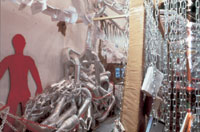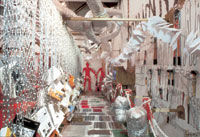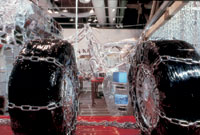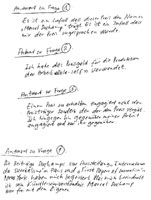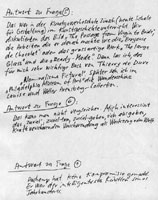On December 1st, 2000, Thomas Hirschhorn was announced the winner of the Prix
Marcel Duchamp, the first time this new award was presented. Aimed at contemporary artists living in France, the winner of the Prix Marcel Duchamp receives FF 200,000 (a little less than US $30,000) and gets a two-month show at the Centre Pompidou, Paris. Hirschhorn’s “Pole-Self” was exhibited there between February 28 — April 30, 2001.
Hirschhorn, of course, is no stranger to the art world. Born in Berne, Switzerland, in1957, he had been on the rise even before Catherine David showed his work at the Jeu de Paume, Paris, in 1994. And with five solo shows in 2001 alone, from Zurich to Barcelona, as well as his participation in major art events such as the Venice Biennale, the demand for his works is way up.
Various installation views of Thomas Hirschhorn’s “Pole Self,”
Paris, Centre Pompidou, February 28 – April 30, 2001
Hirschhorn’s oeuvre is not easy to grasp and almost impossible to forget. Using everyday material such as silver foil, cardboard or duct tape, his installations incorporate entire rooms. His art seems to grow and spread wherever it is displayed. To some viewers Hirschhorn’s environments appear plain ugly, his material too cheap and his eagerness to intellectually involve the visitor is seen as too didactic. To be sure, his is not the inaccessibly polished surface of a Jeff Koons. The use of material is embedded in a democratic and egalitarian notion of the viewer having the possibility to see exactly how his art is made. And art is not only for glances or aesthetic pleasantries but for spending some time with, for engaging the viewer and generating ideas. Often, Hirschhorn builds “altars” or “kiosks” in public spaces, dedicating them to writers and artists such as Raymond Carver or Robert Walser, Meret Oppenheim or Ingeborg Bachmann. He tackles the Holocaust straight-on (no niceties here) and pokes fun at his native country’s obsession with the production of luxury goods. For “Pole Self” Thomas Hirschorn transformed various rooms of the Centre Pompidou into a library, with books attached to metal chains dangling from the ceiling. Other installations included sandbags to wrestle with as well as an “anticapitalist trash heap” in which books on luxury and wealth could be found.
Most recently, in Artforum’s December issue of 2001, London-based art critic Kate Bush praised Hirschhorn’s “distinctive nonaesthetic–based on rickety form, cheap materials, and a blizzard of images and words–[…] powered by a sense of urgency and incomprehension in the face of catastrophe that leaves us, under his unforgiving neon, nowhere to hide.”
 Figure 1Thomas Hirschhorn,
Figure 1Thomas Hirschhorn,
Sas de Contamination, 2000 Figure 2Thomas Hirschhorn,
Figure 2Thomas Hirschhorn,
Raymond Carver-Altar, 2000 Figure 3Thomas Hirschhorn,
Figure 3Thomas Hirschhorn,
Deleuze Monument, 2000
 Figure 4Thomas Hirschhorn,
Figure 4Thomas Hirschhorn,
Critical Laboratory, 2000 Figure 5Thomas
Figure 5Thomas
Hirschhorn, Rolex, etc, Freudlichs Aufstieg and Skulptur-Sortier-Station, 2000 Figure 6Thomas
Figure 6Thomas
Hirschhorn,
Flying Boxes, 1993
*All documentation (figures 1-6) from Gilles Fuchs (ed.), Le Prix Marcel Duchamp 2000 (Paris: ADIAF, 2001)
When awarded the Prix Marcel Duchamp through Gilles Fuchs, the president of the Association pour la Diffusion Internationale de l’Art Français, a simple “Merci” is reported to be all Thomas Hirschhorn said during the ceremony. Tout-Fait wanted to know a little more regarding the artist and his appreciation of Marcel Duchamp. What follows are Hirschhorn’s answers to seven questions we were eager to ask him.
Tout-Fait: Congratulations on the Prix Duchamp 2001. Any idea about why it was you who received it?
Thomas Hirschhorn: It is by chance that the price bears Marcel Duchamp’s name. It is by
chance that the price was given to me.
Tout-Fait: Are there any specific projects you have used your winnings for?
Thomas Hirschhorn:
I have used the money for the production of the work “Pole Self.”
click to enlarge

Figure 7
Marcel Duchamp, Design for
“The Temptation of St. Anthony,”
1946 (on the cover, the
catalogue shows Max Ernst’s
winning entry for the
Hollywood movie The
Private Affairs of Bel Ami)
1946 (on the cover, the catalogue shows Max Ernst’s winning entry for the Hollywood movie The Private Affairs of Bel Ami)
Tout-Fait: Duchamp seemed to despise the very idea of a jury although unlike Breton, he did not refuse awards. In 1946, together with Alfred H. Barr and Sidney Janis, Duchamp chose “The Temptation of St. Anthony”(Fig. 7) from a number of submissions on the same subject to be the winning entry of a competition. Regarding his experience as a juror, Duchamp said: “Jurors are always apt to be wrong…even the conviction of having been fair does not change any doubts on the right to judge at all.”
Thomas Hirschhorn: Receiving an award engages the giver more than it does the laureate. I on the other hand am engaged towards my work and to my work alone.
Tout-Fait: To what extent, if at all, has Duchamp influenced your work?
Thomas Hirschhorn: I enthusiastically embraced Duchamp’s contributions to the Paris exhibition
“Internationale du Surréalisme” (Fig. 8) as well as the show in New York “First Papers of Surrealism” (Fig. 9). What fascinates me is his understanding of being an artist. Marcel Duchamp was free with his own.
- Figure 8
- Figure 9
- Marcel Duchamp, Twelve Hundred
Coal Bags Suspended from the Ceiling
over a Stove, 1938 (part of his
installation for the Exposition
Internationale du Surréalisme, Paris) - Marcel Duchamp, Sixteen
Miles of String, 1942 (part of
his installation for the First Papers
of Surrealism exhibition, NY)
Tout-Fait: Do you remember the first time you became aware of Duchamp’s art?
Thomas Hirschhorn: This was at the Kunstgewerbeschule (School of Applied Arts) in Zurich during art history class. We discussed The Passage from Virgin to Bride (Fig. 10), works he did back then, like The Chocolate Grinder (Fig. 11), or this magnificent Large Glass (Fig. 12) as well as the “Ready-mades.” Then I read the book Pictorial
Nominalism by Thierry de Duve, which was very important to me. Later I saw the wonderful collection of Louise and Walter Arensberg at the Philadelphia
Museum.
click images to enlarge
- Figure 10
- Figure 11
- Figure 12
- Marcel Duchamp,
The Passage from V
irgin, 1912 - Marcel Duchamp,
Chocolate Grinder,
No.1, 1913 - Marcel Duchamp,
The Bride Stripped Bare
by Her Bachelors, Even,
(aka the Large
Glass), 1915-23
Tout-Fait: You once said that what you are interested in is the “doing-too-much, the provision of extra-work, as is the case with light.” Is this statement comparable to Duchamp’s notes about “infra-mince” (a concept first published posthumously in Marcel Duchamp, Notes, Paul Matisse, ed., Boston: G.K. Hall & Company, 1980, notes 1-46), in which he makes known his interest in the warmth of chairs, after sitting on them, the extra-energy used when pushing down a light-switch, etc.
Thomas Hirschhorn:One cannot compare the two. I’m interested in the ‘too much,’ doing too much, giving too much, putting too much of an effort into something. Wastefulness as tool or weapon.
Tout-Fait:Within your works, I sometimes sense the inherent unwillingness to even do as much as to exhibit within the given context of the artworld. Your installation for the Guggenheim Museum Store in Soho was such a total refusal without having to say. In the beginning Duchamp did not exhibit his Ready-mades and often refused to participate in exhibitions. Are your new works in the classic size of large oil on canvas (with picture frame to hang from a wall) a first compromise regarding the possibility of displaying your work (i.e., within the apartments of collectors), comparable to Duchamp’s later editions of the Ready-mades?
Thomas Hirschhorn: Duchamp never made any compromises. He was the most intelligent artist
of his century.
The interview was conducted by Thomas Girst via e-mail and fax. Thomas Hirschhorn’s
answers were sent to ASRL on September 20th, 2001, consisting of two handwritten pages, excl. the cover page. Many thanks to both Ms. Petra Gördüren of Arndt&Partner, Berlin, for establishing contact, as well as to Ms. Sophie Pulicani, studio Thomas Hirschhorn, Paris, for making the images available.
Figs. 7-12
©2002 Succession Marcel Duchamp, ARS, N.Y./ADAGP, Paris.
All rights reserved.




